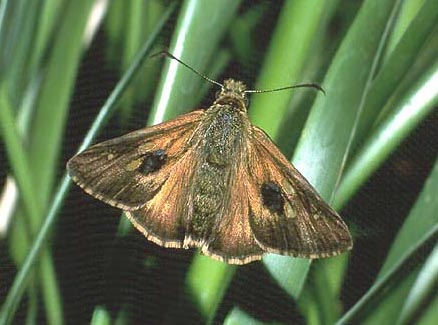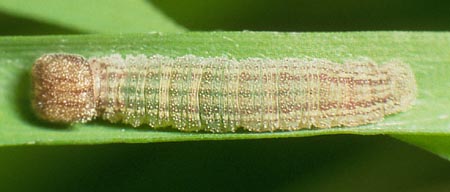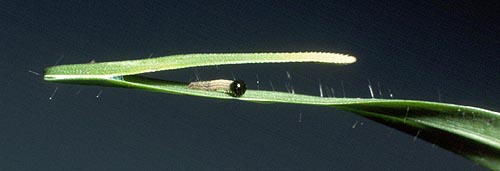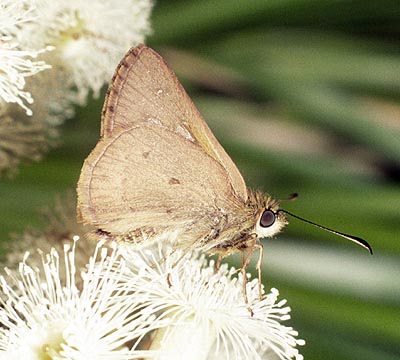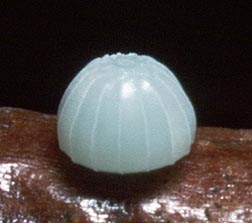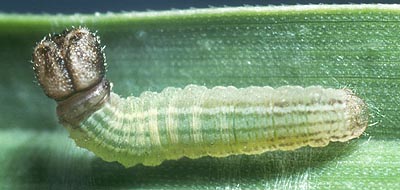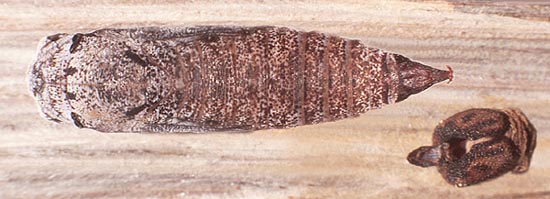-
Larval Food Host
-
Hostplants have not yet been determined in South Australia. In the eastern states the larvae
utilise common grasses. Those grasses that also occur in South Australia include *Agrostis
capillaris (brown-top bent), Poa species incl. P. tenera (slender
tussock grass) and Tetrarrhena spp (rice-grasses). The larvae eat the leaves of the
hostplants.
In captivity in South Australia, larvae prefer Microlaena stipoides
(rice-grass), but will develop on *Brachypodium distachyon (false brome) and
sometimes on *Ehrharta longiflora (annual veldt grass). Young larvae will
eat the soft new growth of *Pennisetum clandestinum (kikuyu), but ultimately this
grass is toxic to the larvae. However, mature larvae can tolerate kikuyu for a
short period. Surprisingly, considering how common the adults are in the wild, the
larvae are extremely fussy eaters in captivity, requiring exacting conditions and
hostplant, such as high humidity and the hostplant to remain in a green condition.
-
Eggs
-
Small, initially pale green, hemi-spherical (domal) with well developed vertical
ribs numbering from 13-16, and additional finer cross latticing. Usually laid singly
on the underside of fallen dead leaves or on vegetal-debris on the ground near its
hostplants that occur in open forest areas. If the egg is fertile then after a couple
of days it acquires a broad, very irregular purplish brown coloured lateral band and
a large dull purplish brown dorsal area, and thereafter the background colour slowly
changes from green to pale yellow.
Larva development within the egg commences immediately after being laid, and the larva is
ready to emerge in about 11-16 days. They eat out the top of the egg a day before
emergence, then just sit inside the egg with their black head blocking the opening.
They will usually wait for moist conditions, like rain or heavy overnight dew before
emerging, but eventually after a few days they have to emerge from the egg and take their
chances with the elements. The larvae are unable to diapause (become torpid) like
Dispar compacta. The egg shell (chorion) is
eaten by the larva after it emerges. The larva then moves off to find suitable hostplant,
testing all likely grass by taking a small nibble out of the leaf edge. When it finds
a suitable hostplant, it will move to the end of the leaf and make a small tubular shelter
in which to hide in, by usually folding the leaf tip back on itself and binding the edges
together with silk. Sometimes they will roll the leaf edges over into a tube.
-
Larvae
-
The first instar is long cylindrical and initially pale greyish yellow with longitudinal
dark brown lines, with a large black circular head that is smooth and shiny, the upper front
part weakly grooved longitudinally. There are a few short dark hairs on both the body and head,
and a few long recurved hairs occur posteriorly. The neck (prothoracic plate) is dark wine
red coloured. The larva is very similar to the first instar larva of
Trapezites symmomus. After eating the hostplant, the larvae
gradually become greenish. The second instar is similar to the late first instar but has a distinct,
broad white longitudinal dorsal band split by a central narrow green dorsal line, and
there is a further narrow white subdorsal line. Obscure remnants of the longitudinal
brown lines occur laterally. The posterior end is brownish. The head is black,
slightly elongate, grooved centrally producing an apical notch, with a fine granular
surface and very short, white bristly hairs. The neck is reddish brown
coloured. The third instar is similar to the second instar, having a similar pattern
of longitudinal lines, mostly green coloured but dorsally brownish, the head differs by
being brown coloured. New shelters are periodically constructed to fit the growing
larvae. The early instar larvae feed at night.
The fourth instar is similar to the third instar but the head is paler brown and
noticeably elongate rectangular shaped. The prothoracic plate is purplish only along the
anterior edge. The lateral edge of the larva is weakly flanged. At this stage
the larvae have usually outgrown the width of the hostplant leaves to construct shelters
from single leaves, and if the leaves are not wide enough (as is the case of many of the
host grasses) then the larvae will either make shelters from several of the host-grass
leaves joined together or start to use loose, rolled leaf and bark debris as shelters,
either caught up within the host grass or lying loose on the ground around the base of the
grass. Once selected the leaf or bark shelter is lined with white silk, with one end
sealed off with strong strands of silk, and the shelter is secured to an adjacent object
also with strong strands of silk. Larval feeding is during the night, and there is
slow growth during the winter months but there is flourishing eating activity during the
warmer spring months and most larvae reach the final fifth instar stage by mid spring.
The fifth and final instar is fat and humped, typical of the Trapezitini Tribe, about
23-26 mm long, initially greenish brown with an indistinct pale, broad dorsal band and a
darker central dorsal line,and a distinct narrow white subdorsal line. The
neck area (prothoracic plate) is similar to the body colour. The head is large,
elongate rectangular from the front, rugose, centrally grooved longitudinally, strongly
notched at the top, the sides and frontal groove are dark brown-black coloured, the
remaining frontal parts on either side of the central groove are brown. The side
mark is wide basally but tapers apically reaching the apex of the head, the edge with the
brown area is straight, the upper part of the frontal groove is edged brown and
this colour combines with the frontal brown area apically, the dark colour of the lower
part of the frontal groove expands laterally into the brown frontal areas as irregular
marks, and there is an additional short elongate isolated dark mark within the apical part
of the brown areas either side of the groove lines. There is a diffuse large brown
inverted V mark in the front lower part. The large frontal brown areas reach the
basal part of the head. The head is covered with very short forward directed, curved
fat, pale setae. The head pattern markings are distinctive for the species and
differ from D.compacta by being generally much paler.
The lateral edge of the larva is strongly flanged. The body is without long hairs,
but is covered with numerous white, squat to occasionally elongate wine-glass shaped
secondary setae set on simple smooth, raised bases. At the posterior end on the anal plate
these setae stand in a small dark brown circular area that produce a brown dotted appearance.
These setae impart a rough scabrous appearance to the larvae. As it grows through the fifth
instar stage the larva becomes more brownish, and eventually by the pre-pupa stage the larva is
pale brown.
The final instar larvae continue to eat and grow strongly into early December but then
slow or cease to eat and become quiescent. By the latter half of December pupation starts
to occur among the larvae and these larvae then pupate at various times and some may not
pupate until late summer or early autumn. These later larvae may periodically feed
to keep up their energy levels.
-
Pupae
-
Short cylindrical, typical of the Trapezitini Tribe, about 15-18 mm long, brown,
but darker brown on the anterior parts of the wings, the abdomen is sometimes very
pale, and the pupa is covered all over with a thin layer of white water repellent
powdery bloom (probably also with anti fungal-bactericide properties) that is very
easily dislodged by any wriggly movements by the live pupa, producing an irregular
pattern of brown under-markings. The thorax of the pupa is humped dorsally.
The head is weakly flattened anteriorly, with the head cap (operculum) being dark
brown coloured. The front (anterior) part of the operculum, is strongly sclerotised
(rugose) and with short, fine simple pale hairs.
There are four pairs of black spots without bloom on the head area, two of the pairs occur
in-line dorsally across the junction of the head with the thorax, a third pair occurs
ventro-anteriorly on the front of the head, and a fourth pair occur laterally on the
eyes. A fifth pair of black marks occur as short elongate marks dorsally at the
posterior edge of the thorax. There are short simple bristly setae (hairs) over most
of the pupa (excepting the wing areas), that become posteriorly directed on the posterior
part of the abdomen. The posterior end of the pupa tapers to a black coloured, long
curved cremaster, which is blunt at the end. The dorsal area of the cremaster has a
series of very fine elongate ridges or striations, and long, brown coloured, splayed
cremaster hooks emanate from the dorsal posterior edge.
Pupation occurs in the final larval shelter. The pupa is secured within the silk lined
shelter by the very strong, cremaster hooks. In captivity in Adelaide the pupal
duration varies from 17-20 days during early summer, but is likely to be longer in the
cooler Southeast Region. The empty pupal case remains inside the shelter after the
adult skipper emerges, and is brown coloured.
-
Flight Period in South Australia
-
The main flight occurs from mid January to mid March, with the odd skipper occurring
into mid April. Only one brood a year.

-
Distribution
-
In South Australia it is confined to the extreme
southeast corner of the Lower Southeast Region in areas with annual rainfall above 600
mm. The skipper is also found in the higher rainfall areas along the coast and Great
Dividing Range in Victoria and New South Wales extending to the border with Queensland.
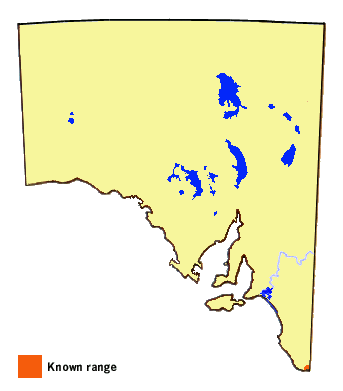
-
Habitat
-
The skipper usually occurs in open forest with a grassy
understorey, growing in cool temperate areas. The early stages of the skipper
require continuous humid conditions.
-
Conservation Status in South Australia
-
Rare in distribution.
Suitable habitat would seem to be reasonably common in the Lower Southeast of South
Australia, yet the skipper remains very restricted, suggesting the early stages have very
exacting requirements. Only known from several, closely situated localities,
and can be locally common where it occurs. Common in the eastern states.
-
Threats
-
The main threat is from toxic spray drift due to the farming and forestry practice
of aerial application of insecticidal sprays.
-
Conservation Strategy
-
Applications of toxic sprays, particularly by aerial means, in farming and forestry
areas near the known localities of the skipper should be judiciously applied.
